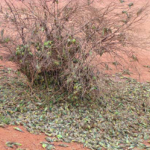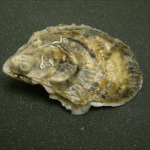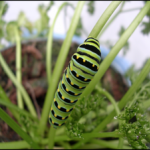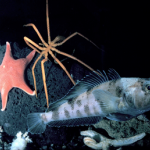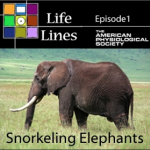
Based on information presented at the Global Change and Global Science: Comparative Physiology in a Changing World conference, August 4-7, 2010 in Westminster, Colorado.
Photo:Budgerigars killed by a heat wave on a ranch in western Australia in 2009 courtesy of Blair Wolf.
Blair Wolf, an associate professor of biology at the University of New Mexico, and Andrew McKechnie at the University of Pretoria in South Africa have been studying how desert bird populations might respond to global warming.
According to a press release from The American Physiological Society (www.the-aps.org),
increases…
The last night of the Comparative Physiology meeting I listened to the neatest lecture on visualizing change in animals given by Dr. Elizabeth Brainerd at Brown University. She provided a wonderful synopsis of imaging techniques throughout history and spoke about using satellites to image large animal migrations all the way down to various microscopy techniques. But what I found most interesting was her description of a contraption called Xâray Reconstruction of Moving Morphology, or XROMM. This new system developed at Brown University allows researchers to view 3 dimensional skeletal images…
I just could not wait to write about a seminar that I listened to at the recent Comparative Physiology conference in Westminster, CO. The topic was "paleophysiology". You got it, the study of physiology in extinct animals! Dr. Thomasz Owerkowicz, an Assistant Project Scientist with Dr. James Hicks at UC Irvine, spoke about his research examining alligators to help understand ancient dinosaurs. Many researchers study modern animals in an effort to understand ancient ones, but the caveat is that they often study them in their modern environment. The novelty of this new research is that Drs.…
Based on information presented at the Global Change and Global Science: Comparative Physiology in a Changing World conference, August 4-7, 2010 in Westminster, Colorado.
Inna Sokolova, associate professor of biology at the University of North Carolina at Charlotte, studies the affect of high carbon dioxide on oyster survival, growth and shell hardness. The results of her research suggest that creatures once thought to be fairly adaptable to changes in the environment, may be in serious trouble.
Photo of oyster courtesy of Inna Sokolova.
Her research group monitored oysters that were kept in…
Based on information presented at the Global Change and Global Science: Comparative Physiology in a Changing World conference, August 4-7, 2010 in Westminster, Colorado.
Jessica Hellmann and her research team at Notre Dame have conducted a series of studies in which manipulating the temperature of the butterfly larvae's environment revealed how the two species might respond to global warming.
Photo: Anise swallowtail caterpillar (Papilio zelicaon)
courtesy of Shannon Pelini.
The team studied the larvae--or caterpillar phase--of two butterfly species, the Propertius duskywing butterfly (…
Based on information presented at the Global Change
and Global Science: Comparative Physiology in a
Changing World conference,
August 4-7, 2010 in Westminster, Colorado
"In trying to predict how species will respond to climate change caused by global warming, researchers and scientists are turning to comparative physiology, a sub-discipline of physiology that studies how different organisms function and adapt to diverse and changing environments. By comparing different species to each other, as well as to members within a species that live in different environments, researchers are learning…
Last full day of the conference. This morning I will take in Global Change and the Emerging Threat of Dead Zones: Can Individuals, Populations, Species and Communities Respond to Increasing Hypoxic Oceans? (Altieri). Also interested in The Physiology of Trace Metal Homeostasis and Toxicity (Grosell). Oral abstracts begin after lunch and poster sessions start late afternoon.
Best of all, tonight is the Awards Banquet. Of the three awards that I'm aware of, my favorite is the Comparative Physiology Section Scholander Award, the most prestigious young investigator award presented by APS in the…
This is a nice area and I have taken the liberty of ducking out on one or two sessions to do some of my own comparative physiology sleuthing. Like most comparative physiologists, some of my best work is done outside the lab.
I think I could live here. This suburban Denver city is the eighth most populous in the state. In 2006, it was ranked 24th in Money magazine's Top 100 Best Places to Live. That was a notch above Ann Arbor, MI.
However, deciding where to live rarely is left up to just one person. Isn't there always a SO (significant other), spouse, offspring in the picture with their…
Greetings from Westminster, CO, site of the 2010 APS Intersociety Meeting: Global Change and Global Science: Comparative Physiology in a Changing World http://the-aps.org/meetings/aps/comparative/index.htm. The meeting is an intersociety meeting, hosted by the American Physiological Society (APS), and co-sponsored by the Society for Integrative and Comparative Biology (SICB) and the Society for Experimental Biology (SEB).
Looked at most of the 221 abstracts for the conference on the plane. Folks from the East coast, West coast, the Southwest, Canada, Norway, France, South Africa and…
I dread packing and flying, but on the planner for August is the 2010 APS Intersociety Meeting: Global Change and Global Science: Comparative Physiology in a Changing World http://the-aps.org/meetings/aps/comparative/index.htm. A must-do meeting for me.
The theme of the meeting is how comparative and evolutionary animal physiologists can contribute to understanding the consequences of global change and how understanding global change requires broad, global science. Seems as if this is the first conference of any type to focus mainly on the effects of global climate change on animal…
Okay, so I am searching the internet looking for information on the reproductive physiology of chickens...and I come across this crazy story of how some chickens are half male and half female. Sounds like an advertisement for a new science fiction movie, doesn't it? After doing some research on the issue (i.e. Googling it), it turns out that this is not a promotion for a movie after all. Scientists from the Roslin Institute at the University Edinburgh have been studying this mysterious rare occurrence of what they call "cell autonomous sex identity", or CASI. According to an article in…
This is my first blog, so bear with me. I asked a friend of mine how I should begin it, and he said, "tell them why they should care about what you will write about." Fair enough.
I teach at a major university in the west. My area of specialty is the comparative physiology of glucose and fatty acid regulation. I specialize in this area because diabetes is such a prevalent concern in the United States. I accepted the invitation to blog on comparative physiology in the hopes that the discussion about this branch of science could grow broader and deeper via the blogosphere. For others thirsting…
